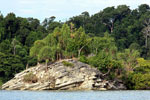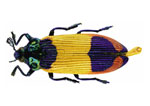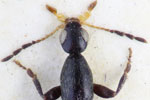Although they live in almost every ecosystem in the world—from your backyard to the Antarctic—scientists know very little about many insect species, including many individual species’ distribution. A new study in mongabay.com’s open-access journal Tropical Conservation Science attempts to predict the range of 53 dung beetle species in the genus Eurysternus, all of which are found in the American tropics. Dung beetles are hugely important to their environments, since they efficiently devour and recycle waste.
“Eurysternus is distributed from central Mexico to southern Brazil. This genus occurs across a broad range of forest conditions and consumes a varied diet of carrion, feces and even leaves,” the researchers write.
By combining 22,000 geo-referenced records of the 53 species, the scientists were able to predict particular species’ climatic needs. With these parameters in mind, the researchers searched for similar climates where the species may reside unrecorded, creating a map of possible distribution for each species. They found that temperature was the most important factor in configuring the distribution of Eurysternus beetles.
“These simulations are useful for designing future surveys aimed at collecting new observations to improve biogeographical and taxonomic knowledge,” the researchers write, noting that surveys for these species are most needed in the Jurua and Rio Branco basins of the upper Brazilian Amazon, between Manaus and Santarem in the lower Amazon, the Brazilian state of Amapám, the Guyanas, Mato Grosso to Paraguay, Honduras, and Nicaragua.
CITATION: Camero-R, E. and Lobo, J. M. 2012. The distribution of the species of Eurysternus Dalman, 1824 (Coleoptera: Scarabaeidae) in America: potential distributions and the locations of areas to be surveyed. Tropical Conservation Science Vol. 5(2):225-244.
Related articles
New book series hopes to inspire research in world’s ‘hottest biodiversity hotspot’

(01/17/2012) Entomologist Dmitry Telnov hopes his new pet project will inspire and disseminate research about one of the world’s last unexplored biogeographical regions: Wallacea and New Guinea. Incredibly rich in biodiversity and still full of unknown species, the region, also known as the Indo-Australian transition, spans many of the tropical islands of the Pacific, including Indonesia’s Sulawesi, Komodo and Flores, as well as East Timor—the historically famous “spice islands” of the Moluccan Archipelago—the Solomon Islands, and, of course, New Guinea. Telnov has begun a new book series, entitled Biodiversity, Biogeography and Nature Conservation in Wallacea and New Guinea, that aims to compile and highlight new research in the region, focusing both on biology and conservation. The first volume, currently available, also includes the description of 150 new species.
Photos: two dozen new beetles discovered in Papua New Guinea hotspot

(11/23/2011) Over the past two decades, at least 24 new beetles species have been discovered in a remote mountainous rainforest region of Papua New Guinea by Swedish entomologists Ulf Nylander. Described in the new book Biodiversity, Biogeography and Nature Conservation in Wallacea and New Guinea, the new beetles found in the Aseki Province are all ecologically linked to rotting wood.
Beetle bonanza: 84 new species prove richness of Indo-Australian islands

(11/08/2011) Re-examining beetle specimens from 19 museums has led to the discovery of 84 new beetle species in the Macratria genus. The new species span the islands of Indonesia, New Guinea, and the Solomon Islands, tripling the number of known Macratria beetles in the region. “Species of the genus Macratria are cosmopolitan, with the highest species diversity in the tropical rainforests. Only 28 species of this genus were previously known from the territory of the Indo-Australian transition,” Dr. Dmitry Telnov with the Entomological Society of Latvia, who discovered the new species, told mongabay.com.
(08/01/2011) New research in the Journal of Applied Ecology shows that ground beetles help farmers in the UK by devouring weed seeds before they can sprout. The researchers say the study finds another proof of how biodiversity—the multitude of species on Earth—provides ‘free’ ecosystem services for people.














